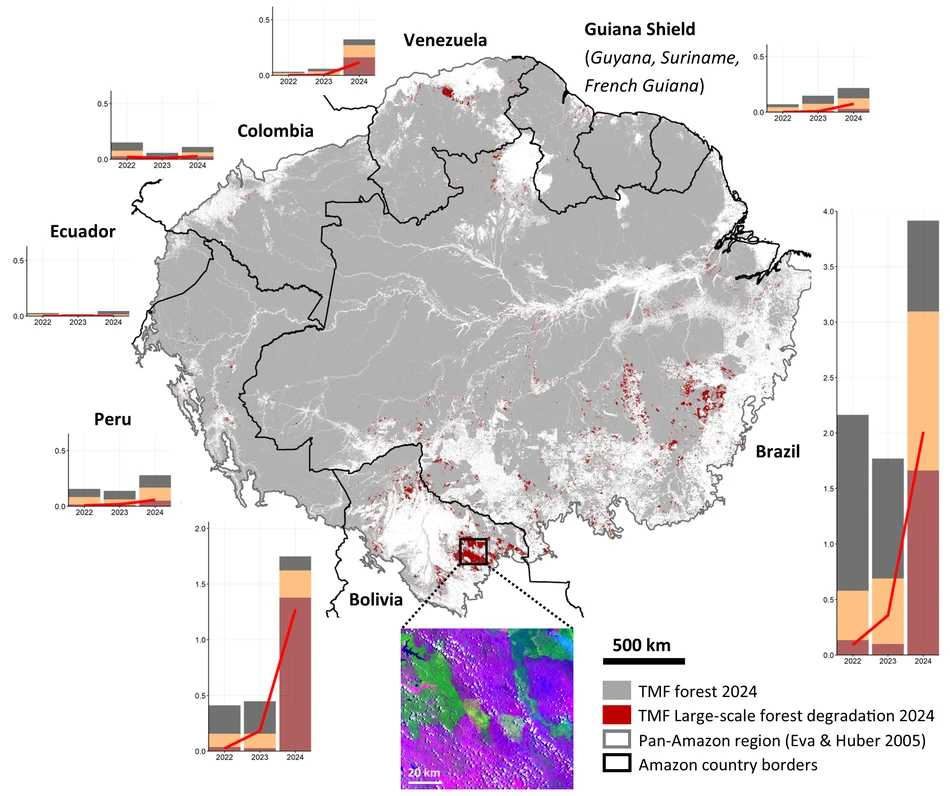Record-breaking 2024 Amazon fires drive unprecedented carbon emissions and ecosystem degradation
8 October 2025
A new study by researchers at the European Commission’s Joint Research Centre reveals that the Amazon rainforest has just undergone its most devastating forest fire season in over two decades, which triggered record-breaking carbon emissions and exposed the region’s growing ecological fragility despite a slowing trend in deforestation. The 2024 fires released an estimated 791 million tons of carbon dioxide into the atmosphere, which roughly equates to the annual emissions of Germany. This marks a sevenfold increase from the average of the previous two years.
According to the study published today in Biogeosciences, 3.3 million hectares of Amazon forest were impacted by fires last year alone. This extraordinary surge in fire activity is likely driven by a combination of extreme drought stress exacerbated by climate change, forest fragmentation, and land-use mismanagement (e.g., escape fires or criminal fires by land grabbers), leading to significant forest degradation. For the first time in the analysis covering 2022–2024, fire-induced degradation has overtaken deforestation as the primary driver of carbon emissions in the Amazon.
This research draws on a sophisticated satellite-based methodology that overcomes many of the limitations of previous global fire datasets. By combining data from the Tropical Moist Forest monitoring system with the Global Wildfire Information System and filtering out false signals caused by agricultural fires or cloud cover, scientists were able to detect and verify fire-driven forest degradation with a novel level of preciseness.

Figure1: Pan-Amazon map showing newly detected large-scale forest degradation in 2024, primarily driven by fires, along with country-level trends in deforestation, forest degradation, and forest fires from 2022 to 2024 (source: Bourgoin et al., 2025)
The geographical spread of the fires was equally alarming. In Brazil, 2024 marked the highest level of emissions from forest degradation on record. In Bolivia, fires affected over 9% of the country’s remaining intact forest cover, which is a dramatic blow to a region that has historically served as a vital biodiversity reservoir and carbon sink.
To ensure scientific rigor and transparency, the researchers used a Monte Carlo simulation framework to estimate carbon emissions and their uncertainties. across variables such as above-ground biomass density, combustion completeness, and the percentage of forest cover affected by fire. The resulting confidence intervals adhere to Intergovernmental Panel on Climate Change (IPCC) best practices and offer a robust benchmark for tracking the carbon consequences of forest fires in tropical regions.
While past reports have highlighted the dangers of deforestation, this study spotlights a more insidious threat: fire-driven degradation that erodes forest integrity without necessarily clearing it. Degraded forests may look intact from above, but they lose a significant portion of their biomass and ecological function. Unlike clear-cut areas, these degraded forests often fall through the cracks of national accounting systems and international policy frameworks.
The study calls for immediate and coordinated action to reduce fire use, strengthen forest protection policies, and support local and Indigenous stewardship efforts. It also highlights the need for enhanced international climate finance mechanisms that recognize and address forest degradation, not just deforestation.
About the EGU
The European Geosciences Union (EGU) is Europe’s premier geosciences union, dedicated to the pursuit of excellence in the Earth, planetary, and space sciences for the benefit of humanity, worldwide. It is a non-profit interdisciplinary learned association of scientists founded in 2002 with headquarters in Munich, Germany. The EGU publishes a number of diverse scientific journals that use an innovative open access format and organises topical meetings plus education and outreach activities. Its annual General Assembly is the largest and most prominent European geosciences event, attracting more than 20,000 scientists from all over the world. The meeting’s sessions cover a wide range of topics, including volcanology, planetary exploration, the Earth’s internal structure and atmosphere, climate, energy, and resources.
If you wish to receive our press releases via email, please use the Press Release Subscription Form. Subscribed journalists and other members of the media receive EGU press releases under embargo (if applicable) 24 hours in advance of public dissemination.
